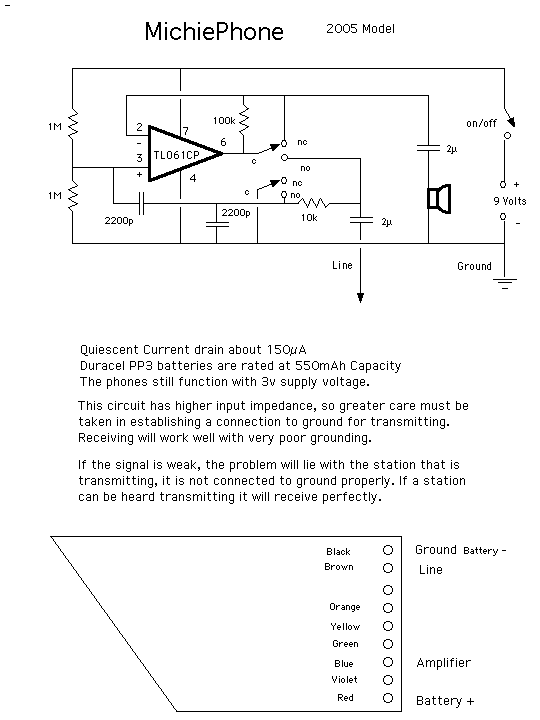The
Single-Wire-Telephone (SWT) has replaced the Army "field telephones" as
the weapon of choice for wired cave and mine rescue
communications. The devices are very simple, using a single
op-amp to both send and receive an audio signal (voice) along a single
insulated wire, using the operators coupling capacitance to ground for
the return. The receiver has a very high input impedance.
Power demand is very low, with many hours (or days) of operation from a
9 Volt battery. Very little coupling to ground is required at the
receive end. The transmit end is mainly driving the distributed
capacitance of the wire to ground. Very long wires (kilometers)
will require fairly good coupling to ground at the transmit end.
Obviously, two-way communications over a very long wire will require
fairly good grounds at both ends such as a small peg in dirt or a bare
wire in water. Neville Mitchie's classic circuit is shown below:


Michael Lake added a high pass filter
(for power line hum) and a low pass filter to reject AM Broadcast
stations, and produced and sold some very nicely constructed
surface-mount SWT's. See http://www.speleonics.com.au/business/index.html
for details and schematic.
A SWT was published in the British CREG Journal. A slightly modified version is at http://www.hamil.org/swt/index.htm . This more complex design includes a standby mode and a ringer.
Desirable features in a rescue SWT include an LED "ON" indicator (only bright enough to see on a cave, could just blink); provision for a ground lead; use of AA cells for a power source (which most cavers carry) or built-in lithium cells (with a foolproof OFF switch) and waterproofness.
A SWT was published in the British CREG Journal. A slightly modified version is at http://www.hamil.org/swt/index.htm . This more complex design includes a standby mode and a ringer.
Desirable features in a rescue SWT include an LED "ON" indicator (only bright enough to see on a cave, could just blink); provision for a ground lead; use of AA cells for a power source (which most cavers carry) or built-in lithium cells (with a foolproof OFF switch) and waterproofness.